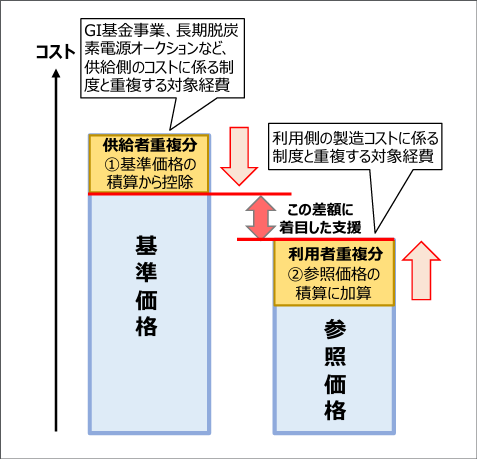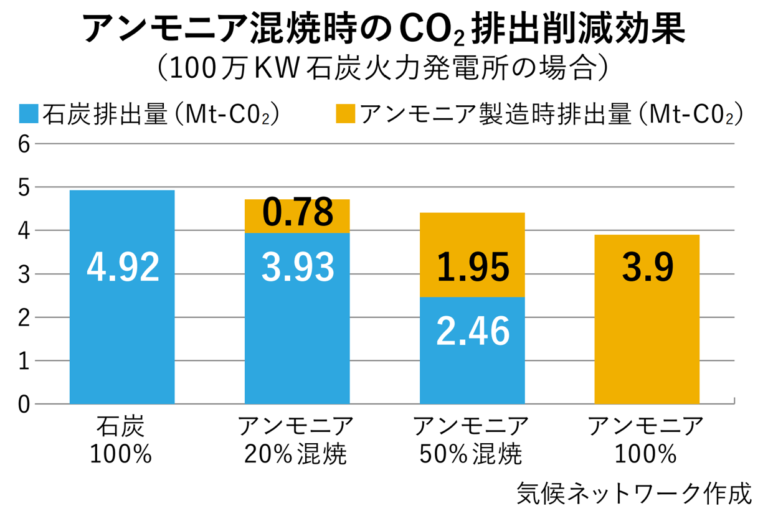Japan is steadily putting systems in place for the use of ammonia fuel both domestically and internationally.
JERA and other power utilities have begun demonstration experiments co-firing ammonia in coal-fired power plants. Plant manufacturers are developing burners and other equipment for ammonia co-firing and 100% ammonia combustion in the future, and other companies are developing related infrastructure such as ports and facilities. However, using ammonia as a fuel and co-firing with coal not only will not lead to decarbonization, but also will fail to solve a number of problems.
*Top picture indicates CO2 emission reductions when ammonia is co-fired in a 1000MW coal-fired power plant. coal:blue, ammonia:orange
Problems with ammonia co-firing
●Insignificant CO2 emission reductions
Co-firing 20% ammonia to reduce the volume of coal burned at a coal-fired power plant will only result in a 1% reduction if gray ammonia, a fossil fuel-derived ammonia, is used.
●High costs
Nearly all ammonia today is produced by synthesizing fossil fuel, making ammonia co-firing more expensive than coal.
●High imports reduce energy security
Currently, ammonia is used for chemical and fertilizer manufacturing, and huge amounts would be needed if it were used as a fuel for power generation. Since Japan is not able to produce enough ammonia domestically, it must import from abroad. As a result, dependence on overseas fuel imports would not decrease, leading to major problems regarding energy security.
●Technology is still under development – much time needed before commercial use
Even though demonstration experiments are progressing, development of ammonia co-firing technology still needs significant time before it can be utilized in large-scale coal-fired power plants. Even in a case where 20% co-firing becomes technically feasible in 2030, no concrete plans have been presented for co-firing in any of the 100+ existing coal-fired power plants in Japan. It is simply not feasible as a timely way of addressing climate change.
Costs of ammonia co-firing
There are some policy issues concerning ammonia co-firing, including the cost.
Co-firing ammonia at existing coal-fired power plants is more expensive than burning fossil fuels such as coal, regardless of whether the ammonia is green (produced from renewables) or gray (produced from fossil fuels). Therefore, the Japanese government has included in 2024’s Hydrogen Society Promotion Act a policy to compensate for the price difference.
This price difference compensation is structured to support all or part of the price difference over a 15-year period, with the base price and reference price determined separately for each project.
Base price (price of hydrogen or ammonia): The price that business operators will provide in advance as a fixed value in order to recover the cost and profit needed to produce and supply hydrogen and hydrogen derivatives such as ammonia..
Reference price (price of fossil fuel): The price of raw fuel to be substituted that will be based on commonly published and referenceable indicators.

Under this mechanism, the costs of developing and promoting hydrogen and ammonia, greenwashed as “decarbonized thermal power” and “zero-emission thermal power”, along with maintaining thermal power, will be accounted for at the price given by operators, and the “difference” will be covered by the government. Currently, the cost of renewable energy is steadily declining around the world, and in some places is even cheaper than generating electricity from fossil fuels. Japan’s persistence in continuing to use fossil fuels with its own technologies will not only delay the shift to renewable energy, but also leave enormous costs to the public.
Currently, Japan is moving to modify or replace old coal-fired power plants for ammonia co-firing or 100% firing in the future. JERA is conducting an ammonia co-firing demonstration experiment at Hekinan Unit 5 in Aichi prefecture, Kyushu Electric Power is conducting tests at Matsuura Unit 2 in Nagasaki prefecture, and others are being conducted in various places throughout Japan. The same is true for hydrogen co-firing experiments with gas-fired power plants.
Recently, automobile manufacturer Mazda submitted the Scoping Document for an Environmental Impact Assessment (EIA) for a plan to replace a coal-fired power unit with a 100% ammonia-fired power unit in its plant at Hiroshima prefecture. It is anticipated that these trends will continue to grow.
Such trends must be closely watched to see if coal-fired power plants in residential areas are actually being phased out, or if they are merely subject to change for ammonia co-firing.
Reference
Renewable Energy Institute: Why Investments in Ammonia Co-firing to Coal Power are not Consistent with the 1.5°C Climate Goal (Link)
CEED: Green groups warn Japan-PH cooperation for ammonia co-firing, hydrogen a threat to energy transition (Link)
E3G: Explained: Why ammonia co-firing in coal power generation is a flawed approach (Link)
Bloomberg: Japan’s Costly Ammonia Coal Co-Firing Strategy (PDF)

